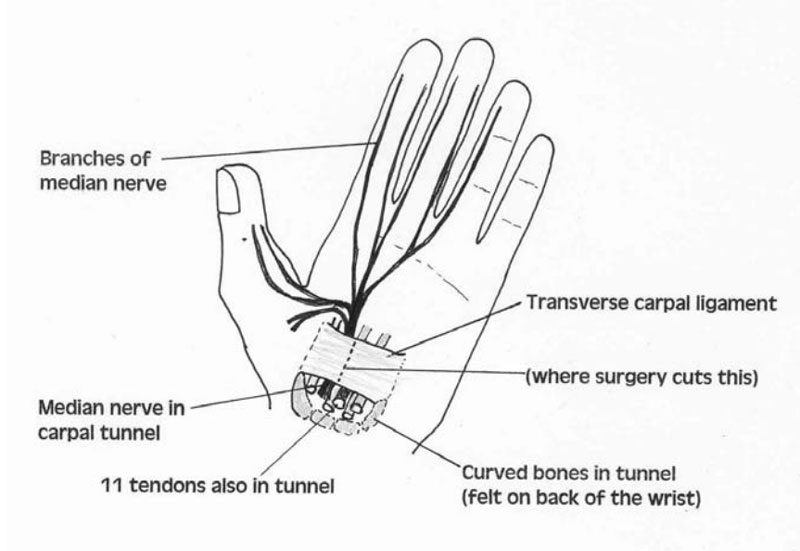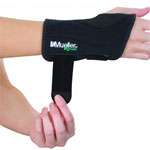
Carpal Tunnel Syndrome (CTS) is the most common nerve disorders, affecting both men and women of different ages. It is responsible for significant morbidity and occupational absence. According to the US Bureau of Labor Statistics, Carpal Tunnel Syndrome is responsible for more days away from work than any other nonfatal injury. Also, employed women, between the ages of 45-64, report CTS at almost double the rate as men for the same age group (statistics by the CDC).
Carpal tunnel syndrome is aggravated by certain activities and pressures that are put on the wrists. Although carpal tunnel syndrome primarily affects the fingers and the hands, it can travel all the way up your arms and into your shoulders.
As with my other posts, some words of disclaimer here, I’m just a researcher, so the information in this post is for informational purposes only and is not provided to replace professional clinical advice from a qualified practitioner.
Searching for carpal tunnel gift ideas? Click on this link to read my related post Gifts for Someone Suffering from Carpal Tunnel Pain. Otherwise, continue reading to learn more about carpal tunnel syndrome causes and relief.
Hand & Wrist Anatomy
The bones of the wrist are arranged like a tunnel. Through this tunnel travel 11 tendons which bend the fingers, and the median nerve. The tunnel is converted into a D-shape by a thick band of fibrous tissue, called the Transverse Carpal Ligament. This is the size of a postage stamp, and is deep in the palm at the wrist. The tunnel can’t change size. Anything that takes up space can squeeze the median nerve.

Who gets Carpal Tunnel Syndrome?
- 10% of the population have Carpal Tunnel Syndrome (some only occasionally).
- People with Diabetes have this more often.
- Ladies often get Carpal Tunnel Syndrome when pregnant, due to fluid shifts.
- Weight lifters get it because they build up the size of their tendons.
- People who work a lot with their hands.
- Someone who has had a fracture near the wrist.
Symtoms
- Tingling or numbness in the arm
- Dull aching in wrist up to elbow
- Stiffness in fingers
- Overall numbness anywhere in the arm
If the numbness is present all the time, the nerve is unlikely to recover fully, which will lead to severe cases of Carpal Tunnel Syndrome. Technically, the problem is with nutrition of the nerve; if it is constantly strangled, scar tissue forms within it. Operating reduces pain and some of the symptoms, but recovery is not full.
Causes
- Excessive use of fingers, hands, wrists and arms
- Constant repetitive motion (such as typing)
- Secondary result of arm or wrist injury
Is there a test for it?
Some doctors request a Nerve Conduction Test, in which tiny needles are used to measure nerve impulse speed. The test, however, is not sensitive. Doctors very often treat patients based on their symptoms and the findings of examination, without a test.
Treating Carpal Tunnel Syndrome
In brief, physical therapy and the possible use of a brace are common recommendation. In rare cases, surgery may be required.

- Splint — This can work very well, especially if symptoms are worse at night. It stops the wrist getting into positions where the nerve is more squashed. I have a post about Gifts for Someone with Carpal Tunnel Pain in which I introduced different products that should help relieve wrist and carpal tunnel pain naturally. Check it out!
- Vitamins — Folic acid (same dose as pregnant women take) and B vitamins. These can help the nutrition of nerves.
- Stretching exercises — The nerves may be tethered in the neck as well. This is called the “double-crush effect,” like treading on a hosepipe in two places.
There are different stretching exercises that you can do to help relieve CTS; however the most common and most effective, I think, is the Titanic stretch.
 “Titanic Stretch” – Like standing on the bow of the Titanic. Arms behind back. Shoulders relaxed. Thumbs up. Elbows straight. Aim to touch fingernails together behind back. Drop left ear onto left shoulder. Breathe slowly. Repeat right side. The important aspects of stretching are:
“Titanic Stretch” – Like standing on the bow of the Titanic. Arms behind back. Shoulders relaxed. Thumbs up. Elbows straight. Aim to touch fingernails together behind back. Drop left ear onto left shoulder. Breathe slowly. Repeat right side. The important aspects of stretching are:
- Stretch the wrist (holding the fingertips and palm away from the forearm)
- Hold a stretch for a few seconds
- Keep your neck supple
- Try to have good posture
- Steroid injection — a small quantity of steroid and local anaesthetic is injected. This can help but is normally to reduce the pain and rarely a permanent solution. The injection can be repeated.
Risks of steroid injection
- Infection
- Not helping
- Weakening tendons
- Pain during the injection
- Damage to small nerve branches
- Making darker skin pale
- Temporary adjustment of insulin requirement in people with diabetes
- Operation — This involves cutting the Transverse Carpal Ligament. It takes about 15 minutes. It’s commonly done under local anesthetic (with an injection into the palm). In some patients, a general anesthetic (putting patients to sleep) is offered.
Risks of carpal tunnel operation operation
- Infection
- Damage to the nerves
- Weakness: Cutting a ligament alters the dynamics of the wrist. It improves over six months. Most people do not notice it, as they often have not used the hand properly due to the symptoms for some time.
- Stiffness
- Recurrence: The ligament reforms with scar tissue. In about 5% of people, this gets tight and they get symptoms again.
- Scar sensitivity
- Persistent numbness or weakness: If the Carpal Tunnel Syndrome was quite severe before, it may not be possible to get full relief of symptoms.
- Complex Regional Pain Syndrome: Pain and stiffness after hand surgery
After surgery patients should
- Exercise all the joints that you can. Keep moving the fingers.
- Remove the bulky bandage at two days, leaving a clean sticky plaster.
- Keep the hand dry until the stitches come out (usually 10 to 15 days).
- Keep your hand elevated for the first two days (to reduce swelling).
- Avoid lifting heavy objects for a month. Your hand will be weak.
- Massage the scar once the stitches are out.
- Attend any post-op clinics (we often remove stitches and check on exercises then).